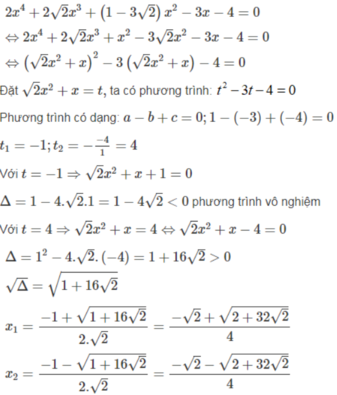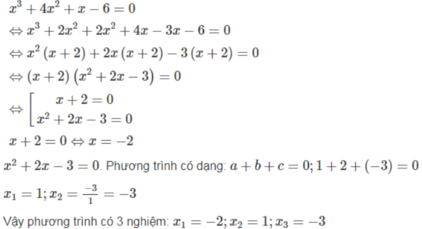Giải phương trình x3 - 3x - 4 = 0

Những câu hỏi liên quan
Giải các phương trình: 2 x 4 + 2 2 x 3 + (1 - 3 2 ) x 2 - 3x - 4 = 0
Bài 5: Giải các phương trình sau:a. (3x - 1)2 - (x + 3)2 0b. x3 dfrac{x}{49}c. x2 - 7x + 12 0d. 4x2 - 3x -1 0e. x3 - 2x - 4 0f. x3 + 8x2 + 17x +10 0g. x3 + 3x2 + 6x + 4 0h. x3 - 11x2 + 30x 0
Đọc tiếp
Bài 5: Giải các phương trình sau:
a. (3x - 1)2 - (x + 3)2 = 0
b. x3 = \(\dfrac{x}{49}\)
c. x2 - 7x + 12 = 0
d. 4x2 - 3x -1 = 0
e. x3 - 2x - 4 = 0
f. x3 + 8x2 + 17x +10 = 0
g. x3 + 3x2 + 6x + 4 = 0
h. x3 - 11x2 + 30x = 0
a. (3x - 1)2 - (x + 3)2 = 0
\(\Leftrightarrow\left(3x-1+x+3\right)\left(3x-1-x-3\right)=0\)
\(\Leftrightarrow\left(4x+2\right)\left(2x-4\right)=0\)
\(\Leftrightarrow4x+2=0\) hoặc \(2x-4=0\)
1. \(4x+2=0\Leftrightarrow4x=-2\Leftrightarrow x=-\dfrac{1}{2}\)
2. \(2x-4=0\Leftrightarrow2x=4\Leftrightarrow x=2\)
S=\(\left\{-\dfrac{1}{2};2\right\}\)
Đúng 3
Bình luận (0)
b. \(x^3=\dfrac{x}{49}\)
\(\Leftrightarrow49x^3=x\)
\(\Leftrightarrow49x^3-x=0\)
\(\Leftrightarrow x\left(49x^2-1\right)=0\)
\(\Leftrightarrow x\left(7x+1\right)\left(7x-1\right)=0\)
\(\Leftrightarrow x=0\) hoặc \(7x+1=0\) hoặc \(7x-1=0\)
1. x=0
2. \(7x+1=0\Leftrightarrow7x=-1\Leftrightarrow x=-\dfrac{1}{7}\)
3. \(7x-1=0\Leftrightarrow7x=1\Leftrightarrow x=\dfrac{1}{7}\)
Đúng 2
Bình luận (0)
*Cách khác:
a) Ta có: \(\left(3x-1\right)^2-\left(x+3\right)^2=0\)
\(\Leftrightarrow\left(3x-1\right)^2=\left(x+3\right)^2\)
\(\Leftrightarrow\left[{}\begin{matrix}3x-1=-x-3\\3x-1=x+3\end{matrix}\right.\Leftrightarrow\left[{}\begin{matrix}4x=-2\\2x=4\end{matrix}\right.\Leftrightarrow\left[{}\begin{matrix}x=-\dfrac{1}{2}\\x=2\end{matrix}\right.\)
Vậy: \(S=\left\{-\dfrac{1}{2};2\right\}\)
Đúng 2
Bình luận (0)
Xem thêm câu trả lời
Giải phương trình: (x – 1)(x2 + 3x – 2) – (x3 – 1) = 0.
(x – 1)(x2 + 3x – 2) – (x3 – 1) = 0
⇔ (x – 1)(x2 + 3x - 2) - (x - 1)(x2 + x + 1) = 0
⇔ (x – 1)[(x2 + 3x - 2) - (x2 + x + 1)] = 0
⇔ (x – 1). (x2 + 3x - 2 - x2 - x - 1) = 0
⇔ (x – 1)(2x - 3) = 0
⇔ x - 1 = 0 hoặc 2x - 3 = 0
+) Nếu x - 1 = 0 ⇔x = 1
+) Nếu 2x - 3 = 0 ⇔x = 3/2
Vậy tập nghiệm của phương trình là S = {1;3/2}
Đúng 0
Bình luận (0)
Phân tích vế trái thành nhân tử, giải phương trình sau: x3 – 3x2 + 3x – 1 = 0
x3 – 3x2 + 3x - 1 = 0
⇔ (x – 1)3 = 0 (Hằng đẳng thức)
⇔ x – 1 = 0
⇔ x = 1.
Vậy tập nghiệm của phương trình là S={1}.
Đúng 0
Bình luận (0)
Bài 6: Giải các phương trình sau:2) 3) 4) 5) 6) 7) 8) 9) 10) 11) 12) 13) 14) x2 – 2x + 1 015) 1 + 3x + 3x2 + x3 0
Đọc tiếp
Bài 6: Giải các phương trình sau:
2) |
3) |
4) |
5) |
6) |
7) |
8)
9)
10)
11)
12)
13)
14) x2 – 2x + 1 = 0
15) 1 + 3x + 3x2 + x3 = 0
4) Ta có: \(\dfrac{2x-5}{5}-\dfrac{x+3}{3}=\dfrac{2-3x}{2}-x-2\)
\(\Leftrightarrow\dfrac{6\left(2x-5\right)}{30}-\dfrac{10\left(x+3\right)}{30}=\dfrac{15\left(2-3x\right)}{30}-\dfrac{30\left(x+2\right)}{30}\)
\(\Leftrightarrow12x-30-10x-30=30-45x-30x-60\)
\(\Leftrightarrow-22x-60=-75x-30\)
\(\Leftrightarrow-22x+75x=-30+60\)
\(\Leftrightarrow53x=30\)
\(\Leftrightarrow x=\dfrac{30}{53}\)
Vậy: \(S=\left\{\dfrac{30}{53}\right\}\)
5) Ta có: \(\dfrac{5x-3}{6}-\dfrac{7x-1}{4}=5\)
\(\Leftrightarrow\dfrac{2\left(5x-3\right)}{12}-\dfrac{3\left(7x-1\right)}{12}=\dfrac{60}{12}\)
\(\Leftrightarrow10x-6-21x+3=60\)
\(\Leftrightarrow-11x-3=60\)
\(\Leftrightarrow-11x=63\)
\(\Leftrightarrow x=-\dfrac{63}{11}\)
Vậy: \(S=\left\{-\dfrac{63}{11}\right\}\)
Đúng 1
Bình luận (1)
`9,x^3+x^2-2=0`
`x^3-x^2+2x^2-2=0`
`<=>x^2(x-1)+2(x-1)(x+1)=0`
`<=>(x-1)(x^2+2x+2)=0`
`<=>x=1`
`14,x^2-2x+1=0`
`<=>(x-1)^2=0`
`<=>x-1=0`
`<=>x=1`
`15,x^3+3x^2+3x+1=0`
`<=>(x+1)^3=0`
`<=>x+1=0`
`<=>x=-1`
Đúng 2
Bình luận (0)
Bài 6: Giải các phương trình sau:1) 2) 3) 4) 5) 6) 7) 8) 9) 10) 11) 12) 13) 14) x2 – 2x + 1 015) 1 + 3x + 3x2 + x3 0
Đọc tiếp
Bài 6: Giải các phương trình sau:
1) |
2) |
3) |
4) |
5) |
6) |
7) |
8)
9)
10)
11)
12)
13)
14) x2 – 2x + 1 = 0
15) 1 + 3x + 3x2 + x3 = 0
Bài 6:
1) Ta có: \(2x\left(x-5\right)-\left(x+3\right)^2=3x-x\left(5-x\right)\)
\(\Leftrightarrow2x^2-10x-\left(x^2+6x+9\right)=3x-5x+x^2\)
\(\Leftrightarrow2x^2-10x-x^2-6x-9-3x+5x-x^2=0\)
\(\Leftrightarrow-14x-9=0\)
\(\Leftrightarrow-14x=9\)
\(\Leftrightarrow x=-\dfrac{9}{14}\)
Vậy: \(S=\left\{-\dfrac{9}{14}\right\}\)
Đúng 5
Bình luận (0)
`1)2x(x-5)-(x+3)^2=3x-x(5-x)`
`<=>2x^2-10x-x^2-6x-9=3x-5x+x^2`
`<=>x^2-16x-9=x^2-2x`
`<=>14x=-9`
`<=>x=-9/14`
Đúng 3
Bình luận (0)
Giải phương trình:
a) 2x2 + 3x - 27 =0
b) -10x2 + x + 3 =0
c) -x3 + x2 + 4 =0
d) x3 - 4x2 - 8x +8 =0
a: =>2x^2+9x-6x-27=0
=>x(2x+9)-3(2x+9)=0
=>(2x+9)(x-3)=0
=>x=3 hoặc x=-9/2
b: =>-10x^2+6x-5x+3=0
=>-2x(5x-3)-(5x-3)=0
=>(5x-3)(-2x-1)=0
=>x=-1/2 hoặc x=5/3
c: =>-x^3+2x^2-x^2+4=0
=>-x^2(x-2)-(x-2)(x+2)=0
=>(x-2)(-x^2-x-2)=0
=>x-2=0
=>x=2
d: =>(x^3+8)-4x(x+2)=0
=>(x+2)(x^2-2x+4)-4x(x+2)=0
=>(x+2)(x^2-6x+4)=0
=>x=-2 hoặc \(x=3\pm\sqrt{5}\)
Đúng 2
Bình luận (0)
Giải phương trình:
a)x2-11x+15=-15
b)2x-3x+10=x
c)x3-4=4
d)x4+x3-x2-x=0
\(a.x^2-11x+15=-15.\Leftrightarrow x^2-11x+30=0.\)
\(\Leftrightarrow\left(x-6\right)\left(x-5\right)=0.\Leftrightarrow\left[{}\begin{matrix}x=6.\\x=5.\end{matrix}\right.\)
\(b.2x-3x+10=x.\Leftrightarrow-2x+10=0.\Leftrightarrow x=5.\)
\(c.x^3-4=4.\Leftrightarrow x^3=8.\Leftrightarrow x^3=2^3.\Rightarrow x=2.\)
\(d.x^4+x^3-x^2-x=0.\Leftrightarrow x^2\left(x^2+x\right)-\left(x^2+x\right)=0.\Leftrightarrow\left(x^2-1\right)\left(x^2+x\right)=0.\)
\(\Leftrightarrow\left(x-1\right)\left(x+1\right)x\left(x+1\right)=0.\Leftrightarrow\left(x-1\right)\left(x+1\right)^2x=0.\)
\(\Leftrightarrow\left[{}\begin{matrix}x-1=0.\\x+1=0.\\x=0.\end{matrix}\right.\) \(\Leftrightarrow\left[{}\begin{matrix}x=1.\\x=-1.\\x=0.\end{matrix}\right.\)
Đúng 3
Bình luận (0)
Trong các bất phương trình sau đâu là bất phương trình bậc nhất một ẩn? Vì sao?a)
−
2
x
+
3
0
;
b)
x
3
−
5
4
0
;
c)
1
x
+
4
≤
0
;
d)
−
3
x...
Đọc tiếp
Trong các bất phương trình sau đâu là bất phương trình bậc nhất một ẩn? Vì sao?
a) − 2 x + 3 > 0 ; b) x 3 − 5 4 = 0 ;
c) 1 x + 4 ≤ 0 ; d) − 3 x − 8 4 ≥ 0 .
a) Không, vì ẩn x nằm trong dấu giá trị tuyệt đối.
b) Không, vì dấu "=" thể hiện đó là phương trình.
c) Không, vì ẩn x nằm ở mẫu số.
d) Có.
Đúng 0
Bình luận (0)
Giải các phương trình: x 3 + 4 x 2 + x - 6 = 0

















